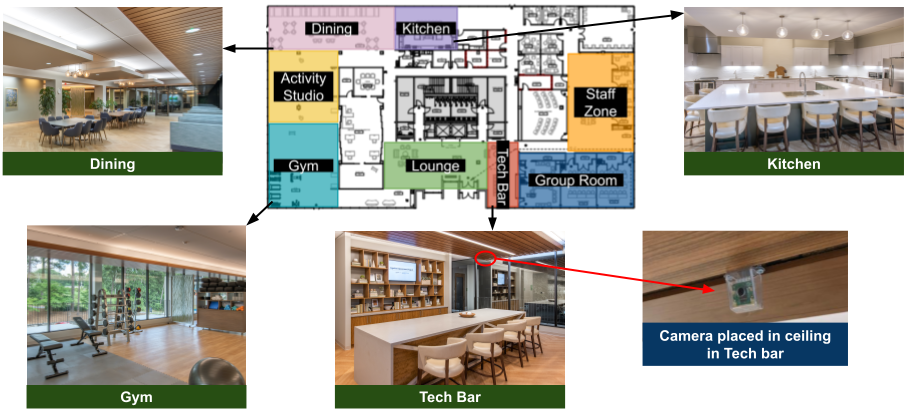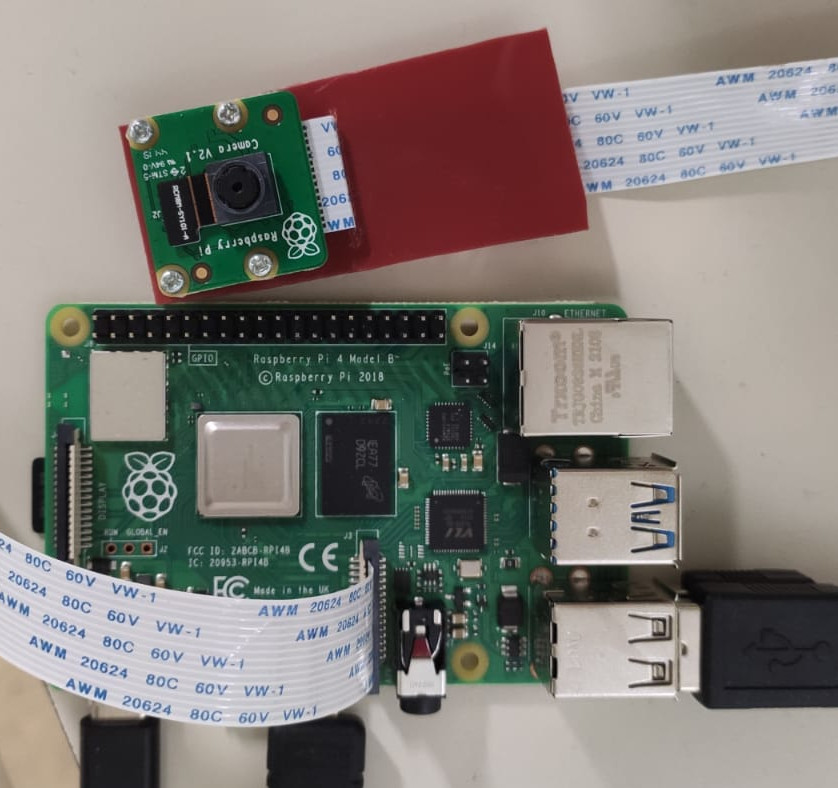Feasibility of assessing cognitive impairment via distributed camera network and privacy-preserving edge computing

0

Sign in to get full access
Overview
- This paper explores the feasibility of using a distributed camera network and privacy-preserving edge computing to assess cognitive impairment.
- The research aims to develop a non-invasive approach that can detect early signs of cognitive decline without compromising user privacy.
Plain English Explanation
The researchers in this study looked at whether it's possible to use a network of cameras and some special computer processing techniques to detect signs of cognitive impairment, like memory or thinking difficulties, in people. The key idea is to do this in a way that protects people's privacy, so the cameras and computers don't store or share personal information.
The researchers wanted to find a non-invasive way to potentially catch the early signs of cognitive problems, like Alzheimer's disease, before they become severe. Traditional methods often require people to come into a clinic and undergo tests, which can be inconvenient and uncomfortable. This new approach could allow for monitoring cognitive health in a person's everyday environment, like their home, without being too intrusive.
The paper explores the technical details of how this camera network and privacy-preserving computing system could work. It also discusses the potential benefits and limitations of this approach compared to existing methods for assessing cognitive function.
Technical Explanation
The researchers propose a distributed camera network and privacy-preserving edge computing system to monitor for signs of cognitive impairment. The key components include:
- A network of cameras placed in strategic locations to capture behavioral data, such as movement patterns and facial expressions.
- Edge computing devices that process the camera data locally, without sending raw footage to a central server, to protect user privacy.
- Machine learning models trained to detect subtle indicators of cognitive decline from the processed camera data.
The paper describes the technical architecture and algorithms used to enable this privacy-preserving monitoring system. It also outlines the experimental evaluation of the system's ability to accurately identify cognitive impairment compared to standard clinical assessments.
Critical Analysis
The researchers acknowledge several key limitations and areas for further research:
- The need for further validation of the system's performance with larger and more diverse populations.
- Potential biases in the machine learning models due to demographic factors or differences in individual behavior.
- Concerns about user acceptance and privacy, despite the privacy-preserving design.
Additionally, the paper does not address potential ethical considerations around the use of pervasive monitoring technology, even if it is designed to protect privacy. There may be concerns about the unintended consequences or misuse of such a system.
Conclusion
This research proposes a novel approach to early detection of cognitive impairment using a distributed camera network and privacy-preserving edge computing. If further developed and validated, this system could provide a convenient and non-invasive way to monitor cognitive health and potentially catch the early signs of conditions like Alzheimer's disease. However, the researchers acknowledge the need for additional studies to address the limitations and ensure the system is both effective and ethically sound.
This summary was produced with help from an AI and may contain inaccuracies - check out the links to read the original source documents!
Related Papers


0
Feasibility of assessing cognitive impairment via distributed camera network and privacy-preserving edge computing
Chaitra Hegde, Yashar Kiarashi, Allan I Levey, Amy D Rodriguez, Hyeokhyen Kwon, Gari D Clifford
INTRODUCTION: Mild cognitive impairment (MCI) is characterized by a decline in cognitive functions beyond typical age and education-related expectations. Since, MCI has been linked to reduced social interactions and increased aimless movements, we aimed to automate the capture of these behaviors to enhance longitudinal monitoring. METHODS: Using a privacy-preserving distributed camera network, we collected movement and social interaction data from groups of individuals with MCI undergoing therapy within a 1700$m^2$ space. We developed movement and social interaction features, which were then used to train a series of machine learning algorithms to distinguish between higher and lower cognitive functioning MCI groups. RESULTS: A Wilcoxon rank-sum test revealed statistically significant differences between high and low-functioning cohorts in features such as linear path length, walking speed, change in direction while walking, entropy of velocity and direction change, and number of group formations in the indoor space. Despite lacking individual identifiers to associate with specific levels of MCI, a machine learning approach using the most significant features provided a 71% accuracy. DISCUSSION: We provide evidence to show that a privacy-preserving low-cost camera network using edge computing framework has the potential to distinguish between different levels of cognitive impairment from the movements and social interactions captured during group activities.
Read more8/21/2024


0
Leveraging Persistent Homology for Differential Diagnosis of Mild Cognitive Impairment
Ninad Aithal, Debanjali Bhattacharya, Neelam Sinha, Thomas Gregor Issac
Mild cognitive impairment (MCI) is characterized by subtle changes in cognitive functions, often associated with disruptions in brain connectivity. The present study introduces a novel fine-grained analysis to examine topological alterations in neurodegeneration pertaining to six different brain networks of MCI subjects (Early/Late MCI). To achieve this, fMRI time series from two distinct populations are investigated: (i) the publicly accessible ADNI dataset and (ii) our in-house dataset. The study utilizes sliding window embedding to convert each fMRI time series into a sequence of 3-dimensional vectors, facilitating the assessment of changes in regional brain topology. Distinct persistence diagrams are computed for Betti descriptors of dimension-0, 1, and 2. Wasserstein distance metric is used to quantify differences in topological characteristics. We have examined both (i) ROI-specific inter-subject interactions and (ii) subject-specific inter-ROI interactions. Further, a new deep learning model is proposed for classification, achieving a maximum classification accuracy of 95% for the ADNI dataset and 85% for the in-house dataset. This methodology is further adapted for the differential diagnosis of MCI sub-types, resulting in a peak accuracy of 76.5%, 91.1% and 80% in classifying HC Vs. EMCI, HC Vs. LMCI and EMCI Vs. LMCI, respectively. We showed that the proposed approach surpasses current state-of-the-art techniques designed for classifying MCI and its sub-types using fMRI.
Read more8/29/2024


0
A Cost-Effective Eye-Tracker for Early Detection of Mild Cognitive Impairment
Danilo Greco, Francesco Masulli, Stefano Rovetta, Alberto Cabri, Davide Daffonchio
This paper presents a low-cost eye-tracker aimed at carrying out tests based on a Visual Paired Comparison protocol for the early detection of Mild Cognitive Impairment. The proposed eye-tracking system is based on machine learning algorithms, a standard webcam, and two personal computers that constitute, respectively, the Measurement Sub-System performing the test on the patients and the Test Management Sub-System used by medical staff for configuring the test protocol, recording the patient data, monitoring the test and storing the test results. The system also integrates an stress estimator based on the measurement of heart rate variability obtained with photoplethysmography.
Read more8/13/2024


0
CogniVoice: Multimodal and Multilingual Fusion Networks for Mild Cognitive Impairment Assessment from Spontaneous Speech
Jiali Cheng, Mohamed Elgaar, Nidhi Vakil, Hadi Amiri
Mild Cognitive Impairment (MCI) is a medical condition characterized by noticeable declines in memory and cognitive abilities, potentially affecting individual's daily activities. In this paper, we introduce CogniVoice, a novel multilingual and multimodal framework to detect MCI and estimate Mini-Mental State Examination (MMSE) scores by analyzing speech data and its textual transcriptions. The key component of CogniVoice is an ensemble multimodal and multilingual network based on ``Product of Experts'' that mitigates reliance on shortcut solutions. Using a comprehensive dataset containing both English and Chinese languages from TAUKADIAL challenge, CogniVoice outperforms the best performing baseline model on MCI classification and MMSE regression tasks by 2.8 and 4.1 points in F1 and RMSE respectively, and can effectively reduce the performance gap across different language groups by 0.7 points in F1.
Read more7/19/2024